
Summer in the Philippines is one of the most anticipated seasons of the year for locals and tourists alike. Who wouldn’t be excited about these bright and sunny months? Sapphire seas, azure and clear skies, swaying palms, and sandy beaches await those who seek bliss, tranquility, and relaxation. Add to those the excitement and joy of being in the company of loved ones and friends, and they have the perfect recipe for a perfect summer. Well, we just had such perfect summer trip in Islas de Gigantes, a picturesque island chain in the Western Visayas.
We woke up to a gray and drizzly morning, which filled us with concern. With dark clouds ahead, not only will our photos be less vibrant but the potentially bad weather may cause the boat ride to be quite rough. But after studying the skies for a while, Edcel, our reliable guide, told us not to worry. He said that the day will brighten up later. Well, that’s a relief.
After eating a heavy breakfast, we were excited to get this island hopping adventure underway.
As we looked back at the coastline, we can see how Islas de Gigantes, which belongs to the province of Iloilo, got its namesake. Check out the images below. As you can see in the first photo, a series of hills vaguely outlines the shape of a titanic man lying down (his belly is the hill in the foreground, and the background hill forms his head). The second photo shows the hills outlining a colossal woman’s torso; the twin hills on the left resemble a woman’s breast while the rounded hill looks like her belly. Can you make them out?

On our way to our first destination, we saw this amazing sight. It’s not every day you can find a man standing on a small boat as if it is a powered longboard! Amazingly, he was able to keep his perfect balance while riding the choppy sea.

Check out those beautiful ragged sea cliffs. Constant and incessant erosion by the sea and wind caused their irregular shapes. They resemble those cliffs in Bacuit Bay, El Nido.

Tanke Lagoon
In less than 20 minutes, our boat slowed down and carefully maneuvered itself into a tiny sheltered cove hidden amidst those immense cliffs. It was still a little over 8 AM, but there were already quite a number of pump boats vying for a space to dock. But what is inside here that draws so many people all over the region?
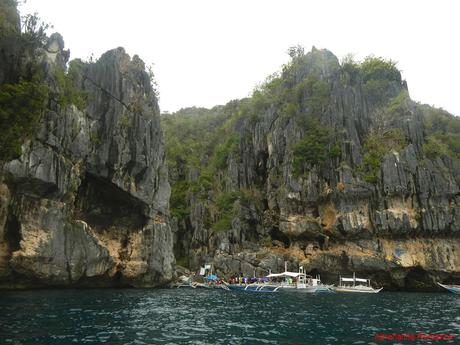
After waiting for a minute, one boat cleared the makeshift floating pier. It was our turn to dock, disembark from our pump boat, and witness the mysterious wonder inside here.

Behold the Tanke, a secret saltwater lagoon surrounded by immense limestone cliffs! Without the locals and foreign tourists, it wouldn’t be impossible to believe that this is a place of sirens and nymphs. Just look at how enchanting it looks.

Let’s take a closer look at the clear, warm saltwater pool. It’s quite large and has several rocky outcroppings where people can climb up to. High diving, however, is prohibited since the water is only neck-deep in most parts.
Locals whisper that on the 24th of June each year during the feast of St. John the Baptist, the water in the Tanke Lagoon magically rises.

Oh, is that an overhanging boulder? You do know what we want to do when we see boulders like these, don’t you?
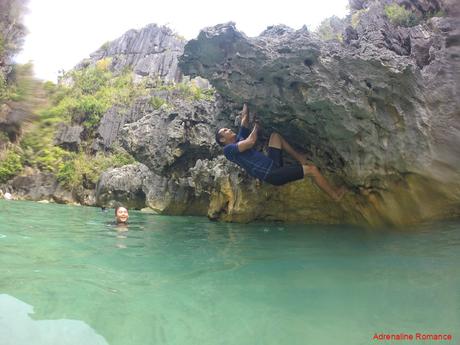
Those towering cliffs must be more than a hundred feet high. But it’s really not a good idea to climb them. The cliffs are dotted with razor-sharp rocks and sharp protrusions that can easily cut skin and muscle.

Unless, of course, you are a monkey. These cool fellows observed their human visitors safely from their hundred-foot perches.
Unlike the monkeys that harass visitors in the Puerto Princesa Underground River, these gentle animals are wary of people and keep themselves out of reach from humans. Local officials prohibit guests from interacting with the monkeys, which should be the case.

After spending an hour frolicking in the secret Tanke Lagoon, it was time to leave to visit our next destination. One last look at Tanke, and we know we are going to miss this ethereal place.
We do hope that tourism officials won’t mar the landscape with any more man-made structures just to make Tanke accessible. Already, there are now ugly concrete steps and poles that look really out of place against the beauty of Tanke Lagoon.

Cabugao Gamay
Our next stop was the sandy Cambugao Gamay (Small Cabugao), a rocky islet just 15 minutes away from Tanke. Virtually all iconic and promotional photos of Islas de Gigantes are taken here.
Edcel was also right about the weather. As the morning wore on, the skies cleared up, and the sun shone beautifully.

Cabugao Gamay has rudimentary facilities for guests. For us, this is perfect; the fewer human structures, the more pristine and natural a destination is. The island has a small restaurant and souvenir shop, a few huts for those who want to stay overnight, and a few tables under the palm trees.

Lovely beach, isn’t it? But the measly groves of green palm trees don’t provide a lot of shade against the burning summer sun. All the more reason why you should cool off in the island’s crystal clear waters right away!

See? We told you. Alexa and Ann couldn’t resist taking a dip. The glass-like water was just the right temperature and incredibly soothing.

Oh, aren’t Line, Em-em, and Sweetie sexy? Go, girls! You gotta show those curves! They can be cover models for swimwear magazines, don’t you think? Hehehe!
Oh those cairns? Locals take some smooth coral stones and stack them together. They believe that these cairns bring them good luck during their voyages around Islas de Gigantes, so be careful not to topple them.

To take that much desired iconic photo of Cabugao Gamay, we have to climb up to that rocky viewing deck. That involved crawling down a small hole under a sea-borne boulder, climbing up some rickety bamboo steps, and scrambling up a short trail of sharp rocks and hot sand.
Don’t leave your flip-flops behind!
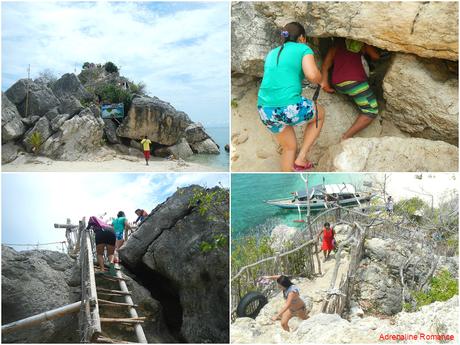
Behold the majesty of the tropical, sandy paradise of Cabugaw Gamay! As you can see, the islet retains much of its unspoiled look. Only a few people climb the rocky hill right across the viewing deck.
Cabugaw Gamay has two white-sand beaches separated by a thin coconut grove. That is more than enough beach for everyone!

Behind the viewing deck, we can see the stunning beauty of this small archipelago. The Philippines is globally known for its gorgeous tropical islands; and thousands of foreigners spend a lot of time, money, and effort just to experience this beauty. It would be a shame for our own countrymen not to see mind-blowing vistas like these in their own homeland.

Bantique Island
By then, our tummies started to grumble, and the pangs of hunger set in. Edcel suggested that we head to nearby Bantique Island so we can order the specialty delicacy of Islas de Gigantes. Being avid and hungry food adventurers that we are, we readily agreed.

Bantique Island is an islet with a tiny fishing community. There must be fewer than a dozen true homes here, so most likely, Bantique serves as a stopover for fishermen plying these waters.

Halourd, Line, and Em relaxed in the free beach lounges provided by the community in Bantique while Sweetie went with Edcel to check what’s for lunch.
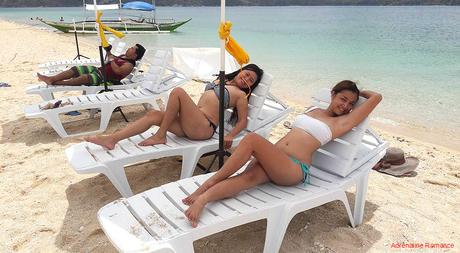
(Photo credit: Line Tubog)
The real jewel of Bantique Island is this long, thin sandbar that gently curves toward the sea. During high tide such as the time we went there, the sandbar is covered with knee-deep water.

After Sweetie returned, the whole group waded along the sandbar to its very tip where we can see a great view of the entire islet. For some reason, the water here is noticeably cooler than the rest of the beach.

We swam in the cool, clear water for almost an hour when Edcel beckoned us to come back to the boat. Whoopee! Lunch was almost ready. But before heading back, we went behind a shack to see what’s cooking. Sweetie ordered a hundred fresh scallops and another hundred oysters for us to eat! Wow! They were boiled to perfection. They’re quite cheap at P1.00 per scallop or oyster.

Cabugao Dako
Since there was a growing number of tourists who were arriving at Bantique Island, Edcel recommended that we head to Phamhel’s beach resort in the neighboring island of Cabugao Dako (Big Cabugao) where we could take our lunch in peace. There were fewer people there at Cabugao Dako since it is not as popular as other destinations in Islas de Gigantes.

As it was already close to 1 PM, we were definitely starving. We got ourselves a table and set up our lunch—steamed scallops and oysters, grilled squid, and grilled pork belly. Yummy! Everyone was talking and laughing, but after this photo was taken, the world suddenly became strangely quiet as hungry adventurers wolfed down these simple but sumptuous dishes. By the way, the steamed scallops and oysters are deliciously sweet!

While our guide and boatman took a short after-lunch nap, we decided to explore the small beach. Aside from its fine white sand, the other highlight is this large rock formation. Swings and platforms are attached to it so guests can have fun swaying and diving into the water.

There’s a small cave beneath the formation. Inside, the presence of the remains of burnt firewood meant that boatmen take shelter here when bad weather or the darkness of the night catches up to them while they’re at sea.

Antonia Island Resort
Soon, we had enough of Cabugao Dako and asked our guide to take us to the next destination. Along the way, we saw jagged rock faces carved eons ago by the wind and sea. They are reminiscent of the karst formations around Sabang Bay in Puerto Princesa, Palawan.

After a short 15-minute cruise, we approached our next destination, Antonia Island Resort. We already felt rewarded after visiting three beautiful destinations, but the surprise and happiness seem to be unending with each idyllic destination we set foot on.

One of the unique characteristics of this island is this slab-like rock wall. With their perfect alignment, you might think that they were hewed by man and machine. But, oh no. Just like other rock formations in Islas de Gigantes, these were formed naturally by the artistry of Mother Nature.

These scanty coconut palm trees barely provide enough shade. So you better slop on a lot of sunblock, wear a long-sleeved rashguard, or bring an umbrella. But what the heck, it’s summer! Don on that bikini or those board shorts!

According to the locals whom we interacted with, originally, these sturdy USAID tents were given to local people who lost their homes when Typhoon Haiyan (Yolanda) struck the country last 2013. Apparently, needing food or money more than shelter, they sold the tents to resort owners to be used as cottages and accommodations. Locals then used the money generated from the sales of the tents to rebuild their lives.

Anyway, enough of the politics. We climbed the slab-like formation, which was much higher than it appears. At the top of the marked trail, we can see this awesome view of Antonia Island Resort. Just like Cabugao Gamay, it is bordered by two lovely white-sand beaches. Choose your beach here!
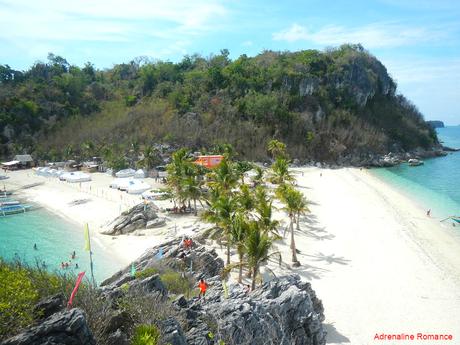
Just look at that incredible aquamarine water and the verdant surroundings. No one can resist getting a dip in that, right?

We gave in to the temptation. Hot and totally drenched with sweat, we went down the rock formation and headed to the beach to cool off. But it’s more than just a picture-perfect tropical beach. Right in front of that rock formation is an expansive coral reef that swimmers can check out. Yes, it’s a snorkeling area.

We strapped on our masks and swam towards the designated snorkeling area. We were totally impressed. The rich and well-maintained reef of Antonia Island rivals that of the most beautiful marine sanctuaries we visited. Since the corals are around 10 feet deep from the water’s surface, they are safe from being damaged by the swimmers’ kicking actions.
Of course, we are not satisfied with just surface snorkeling. So we dived under the water for a closer look at the reef’s gems.
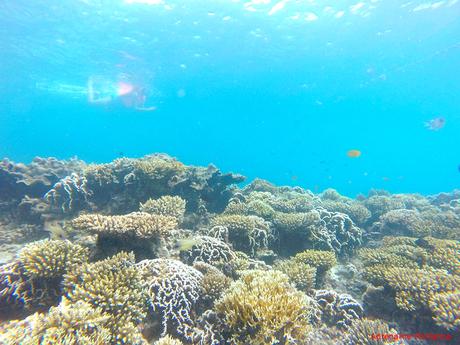
Exploring Antonia Island’s reef is totally fun. We found large schools of fish, sand dollars, anemones, sponges, and corals of all shapes and sizes. We wonder what other secrets does this reef hold. Is there a baby kraken hiding in the dark crevices?

We also found this cool group of sponges basking in the afternoon sun. Hopefully, this beautiful reef will be preserved for many generations to come.

An Isolated Unnamed Beach
Edcel knew that we want a bit of quiet after visiting islands that are filled with families, friends, and tourists. Thus, we exited Antonia Island and headed out to this unknown nook. Aside from a few local fishermen who were preparing to leave the island, not one soul was in sight. For us, this was the perfect place to unwind.

And unwind we did. For the rest of the afternoon, we had the entire beach to ourselves! We don’t mind being marooned in an isolated island as long as it’s a utopia like this.

Is this the tropical Shangri-la that you have been looking for all your life? Isn’t that liquid turquoise rather than plain sea water? Can’t you see how Mother Nature’s beauty dominates everything? This is just paradise!
By the way, that beautiful white sand? It’s as fine as talcum powder!

Soon, the sun started its downward journey to give way to the darkness of the night. Very much satisfied with our island hopping adventure, it was time to go back to the resort and call it a day.
On the way, we saw this huge thunderstorm at the horizon. For us, it was far from ominous. It was beautiful.

Exhausted but exceptionally happy, we arrived at Rosewood Resort just in time to witness a cloud-covered but fiery sunset. A couple of young boys and some sea-loving stray dogs scoured the exposed tidal flats in search for treasures the sea has left behind.
If you feel down and discouraged, just spend a few moments looking at a lovely sunset. Sunsets always fill us with serenity, joy, and a promise for another hopeful day to come.

Special Thanks
We would like to thank our adorable and fun-loving friends Line, Em-em, Ann, and Halourd for joining me, Sweetie and Alexa in this summer adventure. You made this trip extremely fun and totally awesome! You are always welcome to join us on our future sojourns and adventures.

Hold on! We’re not done with our Islas de Gigantes adventures! Stay tuned for our adrenaline-pumping inland tour where we visited an old lighthouse and entered a dark, damp cave.
To get from Iloilo to Estancia, which is the jump-off to Islas de Gigantes, and the pertinent details, check out our teaser. From there, you can ride a commuter pumpboat, rent a pumpboat, or meet your chartered pumpboat to Islas de Gigantes (see below).
Itinerary
Day 3
5:00 AM – wake up, shower, prepare swimming and snorkeling gear
6:00 AM – breakfast
7:00 AM – start island hopping
12:30 PM – Lunch
1:00 PM – resume island hopping
4:30 PM – finish island hopping, head back to resort
5:30 PM – sunset watching
6:00 PM – dinner
8:00 PM – lights out, sleep
Budget*
- Option A: P 6,500 per boat – island hopping rate and guide fee, which include pick-up and drop-off at Estancia on different days. Although the rate is quite high, we opted for this for convenience. We don’t want to be hurrying up to catch the regular commuter pump boat.
- Option B: P 5,000 per boat – island hopping rate and guide fee, which include pick-up and drop-off at Estancia on the same day.
- Option C: P 3,000 per boat – island hopping rate and guide fee, which include island hopping only.
- P 80 per person – commuter pump boat from Estancia to Islas de Gigantes. As far as we know, there is only one round-trip voyage per day. The boat’s name is M/Bca Gerell Passenger Cargo.
11:30 AM – Estancia to Langub Gigante Norte
8:30 AM – Langub Gigante Norte to Estancia
You can now see the reason why we opt to charter a pump boat rather than take the ferry. The schedules are awkward. We arrived at Estancia at noon, which means we would have missed the commuter pump boat. If we took the 8:30 AM trip back to Estancia, we wouldn’t have time to do the inland tour.
- P 150 per person – environmental and terminal fee for guests coming from Estancia
- P 75 per person – environmental and terminal fee for guests coming from Bancal
- P 20 per person – entrance fee for Tanke Lagoon
- P 50 per person – entrance fee for Cabugao Gamay
- P 30 per person – entrance fee for Cabugao Daku
- P 40 per person – entrance fee for Antonia Island Resort
- P 20 per person – habal-habal rate from docking area to Rosewood Resort
- P 250 per person – fan room, per night rate at Rosewood Resort
* We did not include our expenses for meals, snacks, souvenirs, tips, and other fees in this rate sheet as you may have different needs, preferences, itineraries, miscellaneous transportation, and sharing scheme from us. Note that all figures are subject to change without prior notice.
Tips
1. For guideship services, get in touch with Edcel Arnado at 0930-2721063. Since he is also part of the staff of Rosewood Resort, he can arrange your accommodation in the said resort.
2. Make sure to follow up on your guide to check if he has registered your group in the tourism office in Bancal. By virtue of a local ordinance, the tourist traffic there is regulated for safety and to preserve the integrity of the tourism sites. They require boatmen to get a priority number.
3. We recommend starting your island hopping adventure early in the morning where there aren’t many tourists. The charm, serenity, and the feeling of oneness with nature disappears when there are too many visitors around.
4. There are very few restaurants in Islas de Gigantes. In fact, we didn’t see any during our stay there. The most convenient way to acquire food is to order directly from the resort you are booked in.
5. Note that during low tide, the boat may dock away from your resort. Be prepared to shell out money for a habal-habal ride back to your resort.
6. Pack light but bring the following:
- water (at least two liters)
- sandals
- umbrella, hat, or sarong
- snacks and softdrinks
- packed lunch (you can have your resort prepare your lunch or you can buy your meals in the various island destinations)
- swimming attire
- goggles/snorkeling set
- sunblock
- extra clothes
- extra money for emergencies
7. Do not litter and dispose of your garbage properly. Do not throw anything, even organic wastes, to the sea.
8. When snorkeling at Antonia Island Resort, take care not to step on or damage the corals.
9. Keep your sandals, flip-flops, or aqua shoes on to protect your feet from sharp rocks as well as broken glass and other debris that may be hidden under the sand.

